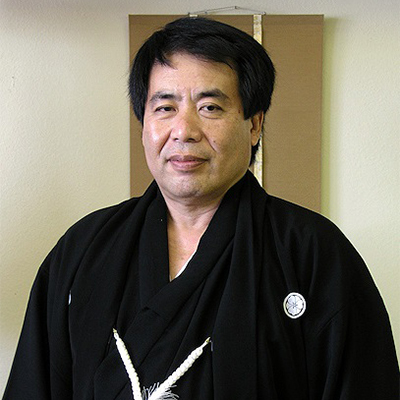
Masayuki Shimabukuro
Shimabukuro Masayuki, fondly known to his friends and students simply as “Shima”, was born in Osaka, Japan 27 March 1948. Although he played the sports of jūdō and kendō in middle school and high school, he considered the true beginning of his training in budō (the Japanese arts of peacemaking) when he undertook instruction in Shōrinji Kempō at the age of 15 under the founder of that system, Sō Dōshin. Two years later he began his study of Hayashi-Ha Shitō-Ryū Karate-Dō under its founder, Hayashi Teruō.
He originally intended to become a lawyer and was admitted to law school after graduating high school, but he soon realized that his first love was budō. After dropping out of law school he worked in a variety of jobs while concentrating on his training in karate-dō. In 1975, at the age of 27, he began training in Musō Jikiden Eishin-Ryū Iaijutsu under the tutelage of its 20th sōshihan (headmaster), Miura Takeyuki Hidefusa.
Shima moved to Escondido, California in 1978 and began teaching karate-dō, iaijutsu, and other forms of Japanese and Okinawan budō at schools and law enforcement agencies there. He also gained local notoriety for his budō demonstrations at the San Diego County Fair and other public events. Once or twice each year he returned to Osaka to visit his family and continue his training. By 1990 Shima had established iaijutsu programs at the University of California, San Diego, and several dōjō throughout Southern California. His growing reputation began to attract attention from other parts of the United States and Mexico, so Miura Sōshihan established an International Division of the Nippon Kobudō Jikishin-Kai and appointed Shima as its chairman.
In 1994, Shima was promoted to nanadan (7th degree) and awarded the prestigious title of Kyōshi by Miura Sōshihan. He also opened his own dōjō in San Diego, California, and began working with his senior student, Leonard Pellman, to write a comprehensive textbook on the art and philosophy of Musō Jikiden Eishin-Ryū Iaijutsu. The following year, with the approval and encouragement of Miura Sōshihan, he established the Jikishin-Kai International (JKI). Later that year, Flashing Steel: Mastering Eishin-Ryū Swordsmanship was published by North Atlantic Books and quickly became the best selling book on iaijutsu in the English language.
With the publication of Flashing Steel came global recognition of Shima’s mastery of iaijutsu and other forms of Japanese budō. Flashing Steel was a major factor in the sudden rise in popularity of iaijutsu throughout the world. Within ten years, iaijutsu went from an art rarely taught outside Japan to having more practitioners outside Japan than in its native land. In 2000, Shima was promoted to hachidan (8th degree) and awarded the title of Hanshi—the highest accolade accorded to practitioners of budō. The second edition of Flashing Steel was published in 2008, the same year the Dai Nippon Butoku Kai, Japan’s oldest and most prestigious governing body selected Shima as its International Division representative for the art of iaijutsu.
In 2009, Miura Takeyuki was forced to retire from public life due to Parkinson’s disease, and Shima was appointed his successor as the 21st Sōshihan of Musō Jikiden Eishin-Ryū Iaijutsu. This was an unprecedented act, because Shima was then a naturalized American citizen and thus became the first foreigner to lead a classical style of Japanese budō. The following year, Shima was diagnosed with cancer of the gall bladder. During surgery it was discovered that the cancer had spread to his liver and lymphatic system. True to his training, he fought valiantly against the disease for two years while continuing his grueling schedule of world travel to spread the art of iaijutsu. During that period, he and Leonard Pellman rushed to complete about two-thirds of a second book on karate-dō. On 07 September 2012, Shimabukuro Masayuki Hidenobu succumbed to his illness, but his legacy lives on in his body of work and the thousands of students he trained. In 2013, the Dai Nippon Butoku Kai posthumously inducted him into their Hall of Fame for his lifetime of contributions to the arts and people he loved.
